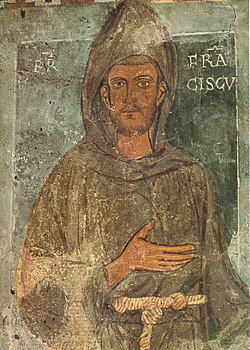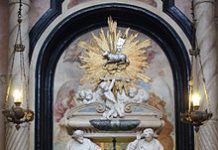
BENEDICT XVI
GENERAL AUDIENCE
Paul VI Audience Hall
Wednesday, 27 January 2010
Saint Francis of Assisi
Dear Brothers and Sisters,
In a recent Catechesis, I illustrated the providential role the Orders of Friars Minor and the Order of Preachers, founded by St Francis of Assisi and St Dominic de Guzmán respectively, played in the renewal of the Church in their day. Today I would like to present to you the figure of Francis, an authentic “giant” of holiness, who continues to fascinate a great many people of all age groups and every religion.
“A sun was born into the world”. With these words, in the Divine Comedy (Paradiso, Canto XI), the great Italian poet Dante Alighieri alludes to Francis’ birth, which took place in Assisi either at the end of 1181 or the beginning of 1182. As part of a rich family his father was a cloth merchant Francis lived a carefree adolescence and youth, cultivating the chivalrous ideals of the time. At age 20, he took part in a military campaign and was taken prisoner. He became ill and was freed. After his return to Assisi, a slow process of spiritual conversion began within him, which brought him to gradually abandon the worldly lifestyle that he had adopted thus far. The famous episodes of Francis’ meeting with the leper to whom, dismounting from his horse, he gave the kiss of peace and of the message from the Crucifix in the small Church of St Damian, date pack to this period. Three times Christ on the Cross came to life, and told him: “Go, Francis, and repair my Church in ruins”. This simple occurrence of the word of God heard in the Church of St Damian contains a profound symbolism. At that moment St Francis was called to repair the small church, but the ruinous state of the building was a symbol of the dramatic and disquieting situation of the Church herself. At that time the Church had a superficial faith which did not shape or transform life, a scarcely zealous clergy, and a chilling of love. It was an interior destruction of the Church which also brought a decomposition of unity, with the birth of heretical movements. Yet, there at the centre of the Church in ruins was the Crucified Lord, and he spoke: he called for renewal, he called Francis to the manual labour of repairing the small Church of St Damian, the symbol of a much deeper call to renew Christ’s own Church, with her radicality of faith and her loving enthusiasm for Christ. This event, which probably happened in 1205, calls to mind another similar occurrence which took place in 1207: Pope Innocent III’s dream. In it, he saw the Basilica of St John Lateran, the mother of all churches, collapsing and one small and insignificant religious brother supporting the church on his shoulders to prevent it from falling. On the one hand, it is interesting to note that it is not the Pope who was helping to prevent the church from collapsing but rather a small and insignificant brother, whom the Pope recognized in Francis when he later came to visit. Innocent III was a powerful Pope who had a great theological formation and great political influence; nevertheless he was not the one to renew the Church but the small, insignificant religious. It was St Francis, called by God. On the other hand, however, it is important to note that St Francis does not renew the Church without or in opposition to the Pope, but only in communion with him. The two realities go together: the Successor of Peter, the Bishops, the Church founded on the succession of the Apostles and the new charism that the Holy Spirit brought to life at that time for the Church’s renewal. Authentic renewal grew from these together.
Let us return to the life of St Francis. When his father Bernardone reproached him for being too generous to the poor, Francis, standing before the Bishop of Assisi, in a symbolic gesture, stripped off his clothes, thus showing he renounced his paternal inheritance. Just as at the moment of creation, Francis had nothing, only the life that God gave him, into whose hands he delivered himself. He then lived as a hermit, until, in 1208, another fundamental step in his journey of conversion took place. While listening to a passage from the Gospel of Matthew Jesus’ discourse to the apostles whom he sent out on mission Francis felt called to live in poverty and dedicate himself to preaching. Other companions joined him, and in 1209 he travelled to Rome, to propose to Pope Innocent III the plan for a new form of Christian life. He received a fatherly welcome from that great Pontiff, who, enlightened by the Lord, perceived the divine origin of the movement inspired by Francis. The Poverello of Assisi understood that every charism as a gift of the Holy Spirit existed to serve the Body of Christ, which is the Church; therefore he always acted in full communion with the ecclesial authorities. In the life of the Saints there is no contradiction between prophetic charism and the charism of governance, and if tension arises, they know to patiently await the times determined by the Holy Spirit.
Actually, several 19th-century and also 20th-century historians have sought to construct a so-called historical Francis, behind the traditional depiction of the Saint, just as they sought to create a so-called historical Jesus behind the Jesus of the Gospels. This historical Francis would not have been a man of the Church, but rather a man connected directly and solely to Christ, a man that wanted to bring about a renewal of the People of God, without canonical forms or hierarchy. The truth is that St Francis really did have an extremely intimate relationship with Jesus and with the word of God, that he wanted to pursue sine glossa: just as it is, in all its radicality and truth. It is also true that initially he did not intend to create an Order with the necessary canonical forms. Rather he simply wanted, through the word of God and the presence of the Lord, to renew the People of God, to call them back to listening to the word and to literal obedience to Christ. Furthermore, he knew that Christ was never “mine” but is always “ours”, that “I” cannot possess Christ that “I” cannot rebuild in opposition to the Church, her will and her teaching. Instead it is only in communion with the Church built on the Apostolic succession that obedience too, to the word of God can be renewed.
(To continue reading, please see here)…











